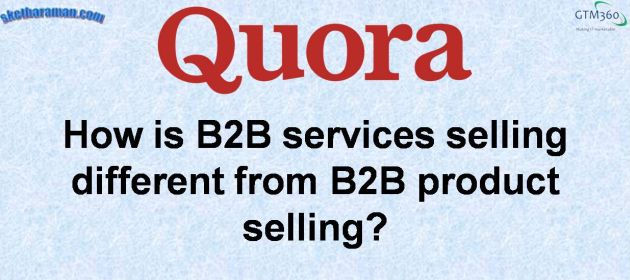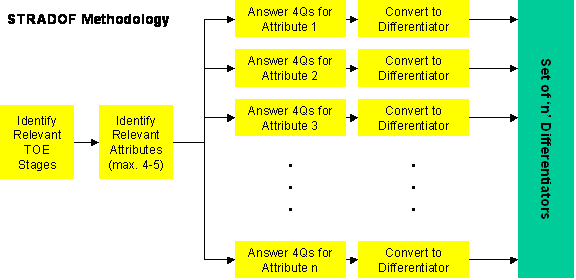This is a slightly edited version of my answer to the following question on Quora:
At the highest level, “selling is selling is selling”.
Sellers of both product and services need to convey the value of their offerings and get paid in return for the value.
Because of this, many tech founders think that there’s no difference between IT product and services selling.
That’s wrong. And akin to thinking that there’s no difference between cricket and football since they’re both sports.
But we know that’s not true. There are indeed many differences between the two games on the ground (pun not intended!).
Likewise, while the goals of product and services selling are the same, the ways to achieve the goals are not the same.
Ergo there are many differences between product and services selling. In this post, I’ll highlight three key differences. In a follow-on post, I’ll cover two more.
This post draws on my experience of working with some of the largest and most valuable Indian and global IT product and services companies for two decades in my corporate life and my subsequent involvement in providing marketing solutions to many small and midsized Indian and global product and services companies over the last decade as an entrepreneur.
With that preamble out of the way, here goes my list.
#1. CAPABILITIES & CREDENTIALS
While both product and services selling follow the same Capability & Credentials selling framework at the high level, the nature of capability and credentials are different between the two realms.
In product selling, Capability hinges on Product, Implementation / Onboarding and Support. In services selling, since there’s no product, Capability revolves around People, Process, Technology and Infrastructure (P-P-T-I).
Differentiation is an integral part of capability selling. In product, differentiation hinges on differences in product features. Again, lacking any product, differentiation must be found on P-P-T-I elements in services selling.
That said, in highly crowded product categories, product feature differences are hard to come by, so the seller will need to find and use non-product related differentiators. Our STRADOF framework is a good way to Look Beyond Features to Find Differentiators in the Total Ownership Experience.
Credential selling hinges on success stories in the case of both product and services selling, but with one important difference. In product, credential selling should reference the future-proof nature of the product and explain how it protected the customer’s investment in it. These things are not so relevant in services credential selling because a services vendor builds what the customer wants today.
#2. RIGID V. FLEXIBLE
Product selling requires the vendor to have a point-of-view and the conviction that “one size fits all”. Articulating these standpoints to prospects and customers often requires pushback by product sales reps, and results in their being perceived as rigid or brash or arrogant.
Flexibility is the hallmark of services selling whose credo is “you tell us what you want, we’ll do it for you”. So, there isn’t so much pushback in the selling process.
More in my blog post titled Developing The Product Mindset.
I've been asked several times to explain the difference between product and services mindset. Even if the bit about "several times" is a slight exaggeration, here's my one-slider. pic.twitter.com/Fd9WoJzpfR
— S.Ketharaman (@s_ketharaman) August 20, 2018
 If a prospect asks for a certain functionality, the product seller does not rush into providing it. Instead, he ascertains the feasibility and impact of implementing them at that specific prospect’s company. For features not supported in his product, he needs to assess the impact of the required changes on the product, work out the effort required to build those features, and then help the customer take a decision whether the extra functionality is worth the cost, time and risk of “creeping featuritis”.
If a prospect asks for a certain functionality, the product seller does not rush into providing it. Instead, he ascertains the feasibility and impact of implementing them at that specific prospect’s company. For features not supported in his product, he needs to assess the impact of the required changes on the product, work out the effort required to build those features, and then help the customer take a decision whether the extra functionality is worth the cost, time and risk of “creeping featuritis”.
This would come across as stonewalling. You don’t do this in services, whose raison d’être is to give what the customer wants.
Just to be clear, this point – and all other points in this post – pertain only to selling. Once the delivery phase starts, it’s customary for a services program / project manager to route changes through a change control mechanism instead of agreeing to them readily.
#3. MARKETING, MARKETING, MARKETING
Product selling requires the ability to rally multiple customers around a single product. Ergo, it requires marketing spend. This is true at any scale. IMHO, product founders who claim otherwise wrongly conflate marketing with advertising.
Just for reference, a typical Silicon Valley product company spends ~$2.5 in Marketing for every $1 in Engineering, with some stalwarts like Salesforce hitting multiples of 4X and and Young Turks like Zoom, 5X.
https://t.co/aSofrhmJn5:
* SG&A is 60% of Revenue
* For every $1 spent on Engineering, SFDC spends $4 on Sales & Marketing#Sales #Marketing #Costshttps://t.co/9iPvzigDRJ pic.twitter.com/Izpalhkj1O— S.Ketharaman (@s_ketharaman) May 2, 2018
In contrast, a services company can get by with very little marketing while it’s small. It’s only to grow beyond a certain size that services selling will need significant marketing spends.
In a follow-on post, I’ll highlight two more differences between IT product and services selling.
Watch this space!

